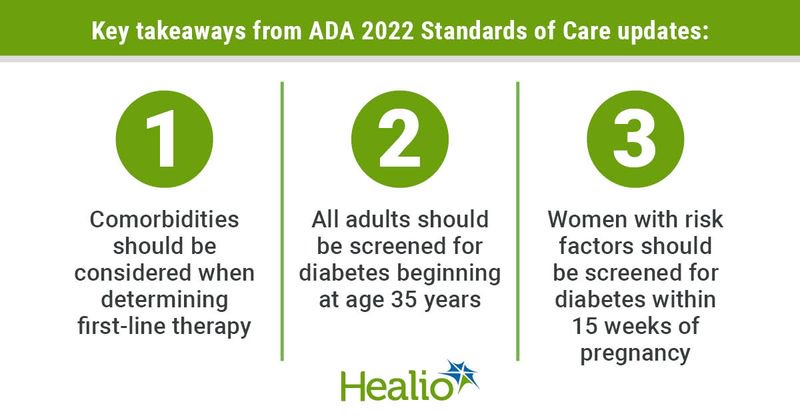First-line therapy, diabetes screening updates among changes in ADA 2022 Standards of Care
Click Here to Manage Email Alerts
Recommendations for first-line therapy and comorbidities, diabetes screening in adults and gestational diabetes testing are among the changes in the American Diabetes Association’s 2022 Standards of Care.
The ADA published its 2022 Standards of Medical Care in Diabetes (Standards of Care) online and as part of a supplement in the January issue of Diabetes Care. The Standards of Care provides the latest evidence-based recommendations for the treatment of type 1, type 2 and gestational diabetes; strategies for preventing or delaying type 2 diabetes; and therapeutic approaches to reduce complications, mitigate cardiovascular and renal risk and improve health outcomes.

“We recognize that health care providers around the world look to our Standards of Care for the latest in how new research can impact care and are excited to provide this valuable resource,” Robert A. Gabbay, MD, PhD, FACP, chief scientific and medical officer for the ADA, said in a press release. “The evidence for the prevention and treatment of diabetes and its complications is constantly evolving, and it is crucial we do our best to keep medical professionals informed on best practices and medical advances in the field of diabetes.”
The 2022 Standards of Care update included new recommendations in several areas.
First-line therapy and comorbidities
The 2022 Standards of Care puts a more individualized focus on first-line therapy for adults with type 2 diabetes. The choice of a first-line therapy should depend on the patient’s comorbidities, with other factors, such as cost, access and management needs, also playing a role.

“Although metformin is generally the first-line therapy, individuals may be put on other therapies based on their comorbidities, even in the absence of being on metformin,” Gabbay said during a webcast. “Whether somebody has atherosclerotic cardiovascular disease and are high risk, whether they have heart failure or chronic kidney disease, you can see the recommendations on therapy.”
The Standards of Care also includes sections on first-line therapies to minimize hypoglycemia and weight gain.
Screening thresholds for healthy adults
Lower thresholds have expanded the number of adults who should be screened for diabetes and prediabetes. The 2022 Standards of Care recommends screening adults aged 18 years and older with overweight or obesity and other risk factors. Additionally, all adults should be screened for prediabetes and diabetes beginning at age 35 years. If tests are normal, screening should be repeated at a minimum of 3-year intervals. The updated recommendations also exclude point-of-care HbA1c testing from the diagnosis of diabetes.
Gestational diabetes screening
The 2022 Standards of Care also puts a greater focus on diabetes screening for women who are planning to be become pregnant or are in the early stages of pregnancy. Women in the preconception stage should be screened for diabetes if they have risk factors. Providers should also consider screening all women planning to become pregnant for undiagnosed diabetes before conception.
Similarly, pregnant women with risk factures should be screened prior to 15 weeks. All women with undiagnosed diabetes should be screened at the first prenatal visit.
Technology and devices
The updated diabetes technology section has a greater focus on individualizing device recommendations and utilization. Blood glucose monitoring should be provided to all continuous glucose monitor users for calibration, verification of blood glucose, and for use if a CGM is unavailable.
The updated CGM recommendations combine real-time and intermittently scanned CGM systems with differing levels of evidence.
“Either of those devices should be offered to adults with diabetes who are on multidose insulin injections or a continuous subcutaneous insulin infusion,” Gabbay said during the webcast. “We updated the recommendations to include those on basal insulin as well.”
CGM should be offered to youths with type 1 diabetes on multiple daily injections or continuous subcutaneous insulin infusion, according to the updated Standards of Care. Another change emphasized the preference of insulin pens over syringes for most people. Syringes can be used with the consideration of patient or caregiver preference, insulin type, cost and self-management capability.
Other changes in this year’s Standards of Care include more information on managing nonalcoholic fatty liver disease and nonalcoholic steatohepatitis with diabetes, the role of health numeracy in diabetes prevention and management, cognitive impairment and diabetes, and new updates on COVID-19.
The ADA’s Professional Practice Committee establishes and revises the Standards of Care each year. The committee is a multidisciplinary team of 16 leading experts in the field of diabetes and includes physicians, diabetes care and education specialists, registered dietitians and others with experience in adult and pediatric endocrinology, epidemiology, public health, lipid research, hypertension, preconception planning and pregnancy care.
The ADA updates the online version of the Standards of Care in real time throughout the year with annotations for new evidence or regulatory changes. Changes will be incorporated through the living Standards of Care process. A webcast with continuing education credit and a full slide deck can be found at DiabetesPro.
Reference:
ADA Standards of Medical Care in Diabetes – 2022. Available at: https://diabetesjournals.org/care/issue/45/Supplement_1. Accessed Jan. 5, 2022
